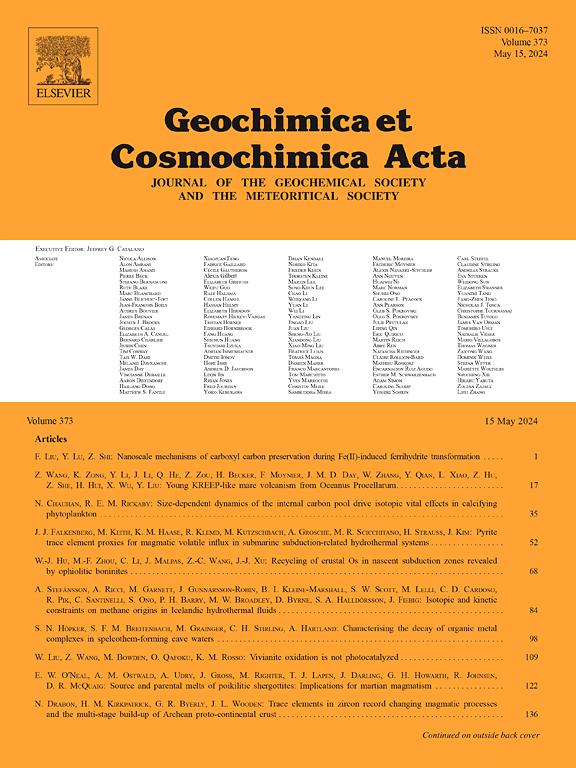一氧化碳球粒陨石中的惰性气体:原始成分、母体热蚀变的影响和宇宙射线暴露年龄
IF 5
1区 地球科学
Q1 GEOCHEMISTRY & GEOPHYSICS
引用次数: 0
摘要
奥南斯型(COs)的碳质球粒陨石包括一些迄今为止已知的最原始的陨石,但它们中的大多数显示出在它们的母小行星上经历过轻微的热变化的证据。先前对水蚀的CM、CR和CY球粒陨石的研究表明,捕获在不同组分中的惰性气体具有不同的易蚀性,可以用来评估母体加工的程度。本文研究了51颗CO球粒陨石的稀有气体组成,岩石学类型为3.0 ~ 3.8,其中3颗疑似梅伊型球粒陨石(CMs);MIL 090073, DOM 10121, DOM 10299)最初被归类为COs, DOM 10900具有介于CMs和COs之间的属性。COs显示了碳质球粒陨石典型的稀有气体混合物,来自于原始载体,如前太阳颗粒、Q相和富ar /V组分的载体,这在无水球粒陨石中观察到,偶尔也在空气中观察到。此外,新发现的W组分可能存在,它对水非常敏感。将我们的结果与文献中的CO稀有气体数据相结合,我们发现20Netr/132Xecorr比值与热蚀变程度最相关(降低),可能与太阳前钻石的丰度有关,因此可以作为热蚀变球粒陨石亚分类的工具。根据其20Netr/132Xecorr比率,DOM 10847(与DOM 08006配对)是最原始的CO,其次是NWA 13464和Y-74135。然而,20Netr/132Xecorr亚分类工具可能不适用于组间比较,因为负责载体的稳定性对母体的化学环境很敏感。大块CO样品中重惰性气体的丰度远高于文献中CO蚀刻残留物(大块陨石脱矿后残留),这表明除了不溶性有机物外,其他载体对重惰性气体存量也有重要贡献,这很容易受到热蚀变的影响。在这项工作中,使用Grossman和Brearley(2005)的方法和Davidson等人(2019)定义的趋势线,DaG 331被细分为CO3.1。这些co的宇宙射线暴露(CRE)年龄在0.17±0.05 Ma (Isna)到78 Ma (DOM 18286测定的最大年龄,不确定度为<;10%),尽管大多数CRE年龄都是>;10马。DOM 18286是迄今为止报道的碳质球粒陨石中CRE年龄最高的。我们没有发现任何暗示重大撞击事件的年龄群,也没有发现CRE年龄与岩石学类型之间的相关性。引人注目的是,分析的63个co中没有一个稀有气体(包括文献)含有太阳风,这表明这一组来自风化层表层以下。COs和CMs显示出相似的基质校正原始稀有气体丰度,表明它们的挥发物来自一个共同的储层。本文章由计算机程序翻译,如有差异,请以英文原文为准。
Noble gases in CO chondrites: Primordial components, effects of parent body thermal alteration, and cosmic ray exposure ages
Carbonaceous chondrites of the Ornans type (COs) include some of the most primitive meteorites known to date, yet most of them show evidence of having experienced mild degrees of thermal alteration in their parent asteroid. Previous studies on aqueously altered CM, CR, and CY chondrites have shown that the noble gases trapped in various components with distinct susceptibility to alteration can be used to assess the extent of parent body processing. In this study, we investigated the noble gas compositions of 51 CO chondrites ranging from petrologic type 3.0 to 3.8, three suspected Mighei-type chondrites (CMs; MIL 090073, DOM 10121, DOM 10299) initially classified as COs, and DOM 10900 with intermediate properties between CMs and COs. The COs show a noble gas mixture typical for carbonaceous chondrites, deriving from primordial carriers such as presolar grains, phase Q, and the carrier of the Ar-rich/V component, which has been observed in anhydrous chondrites, and occasionally air. Additionally, the newly identified W component could be present, which is highly susceptible to water. Combining our results with CO noble gas data from the literature, we show that the 20Netr/132Xecorr ratios correlate best (decrease) with the degree of thermal alteration, likely related to the abundance of presolar diamonds, and may thus serve as tool to subclassify thermally altered chondrites. Based on its 20Netr/132Xecorr ratio, DOM 10847 (paired with DOM 08006) is the most primitive CO, followed by NWA 13464 and Y-74135. The 20Netr/132Xecorr subclassification tool, however, may not be applicable for intergroup comparisons as the stability of the responsible carriers are sensitive to the chemical environment of the parent body. The abundances of heavy noble gases in bulk CO samples are much higher compared to CO etch residues (remaining after demineralization of a bulk meteorite) from the literature, indicating that other carrier(s) than insoluble organic matter must contribute significantly to the heavy noble gas inventory, which is/are susceptible to thermal alteration. DaG 331 was subclassified in this work to be a CO3.1 using the method by Grossman and Brearley (2005) and the trend line defined by Davidson et al. (2019).
The COs show a wide range in cosmic ray exposure (CRE) ages between 0.17 ± 0.05 Ma (Isna) and 78 Ma (maximum age determined for DOM 18286 with an uncertainty of < 10 %), although the majority of CRE ages are > 10 Ma. DOM 18286 has the highest CRE age reported to date for a carbonaceous chondrite. We did not find any age clusters hinting at a major impact event, nor a correlation between CRE ages and the petrologic types. Strikingly, none of the 63 COs analyzed for their noble gases (including literature) contains solar wind, indicating that this group stems from below the regolith surface layer. The COs and CMs show similar matrix-corrected primordial noble gas abundances, suggesting that they accreted their volatiles from a common reservoir.
求助全文
通过发布文献求助,成功后即可免费获取论文全文。
去求助
来源期刊

Geochimica et Cosmochimica Acta
地学-地球化学与地球物理
CiteScore
9.60
自引率
14.00%
发文量
437
审稿时长
6 months
期刊介绍:
Geochimica et Cosmochimica Acta publishes research papers in a wide range of subjects in terrestrial geochemistry, meteoritics, and planetary geochemistry. The scope of the journal includes:
1). Physical chemistry of gases, aqueous solutions, glasses, and crystalline solids
2). Igneous and metamorphic petrology
3). Chemical processes in the atmosphere, hydrosphere, biosphere, and lithosphere of the Earth
4). Organic geochemistry
5). Isotope geochemistry
6). Meteoritics and meteorite impacts
7). Lunar science; and
8). Planetary geochemistry.
 求助内容:
求助内容: 应助结果提醒方式:
应助结果提醒方式:


